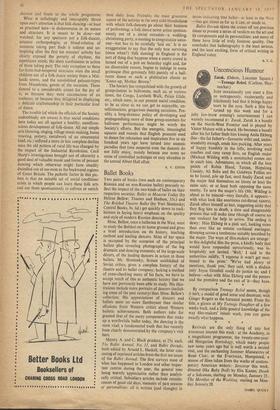Dancing Folk
THE European atmosphere at the close of the nineteenth century was unsympathetic to all forms of the art of dance; and it is more than mere coincidence that the many movements of revival, of re- examination, of rediscovery, in the world of dancing were all manifestations of the decade 1900-10.
The renaissance of all forms of theatre dance has now, fifty years later, brought forth a bounti- ful (if not always appetising) harvest; the aims and efforts of Cecil Sharp and his disciples are less easily analysed and assessed than the reforms carried out in theatre dancing.
On paper, the English Folk Dance and Song Society seems a healthy affair, with over 12,000 members partaking of courses, festivals and the Society's big annual gathering, when (as last week) the Royal Albert Hall is snugly packed for three performances of the New Year Festival. Groups of many ages and sizes, plus one or two soloists in exotic kinds of folk-dance, gave rounds, sword-dances and morrises; and the entire massed strength of youths and maidens from all over perform various kinds of circle-dance as intro- duction and finale to the whole programme.
What is unfailingly and inescapably thrust upon one's attention is that folk-danchig--at least as practised here—is dichotomous in its nature and structure. It is meant to be done—not watched; for any spectator not a folk-dancer, amateur anthropologist, or blood-relation of someone taking part finds it tedious and un- inspiring after the first ten minutes' activity has clearly exposed the poverty of rhythms, the repetitious music, the sheer carelessness in action of those taking part. The only exception to these far-from-bad-tempered strictures were the small children out of a folk-dance society from a Mid- lands towns, and the uninhibited peasant-types from Macedonia, guests of the occasion. These danced to a considerable extent for the joy of it, or because they were unconscious of an audience, or because they delighted in displaying a delicate craftsmanship in their particular kind of dance.
The trouble (of which the officials of the Society undoubtedly are aware) is that social conditions here today are all against a healthy, unselfcon- scious development of folk-dance. All our simple arts (dancing, singing, village music-making, home weaving, pottery, metalwork of an ornamental kind, etc.) suffered a more or less complete decline once the old pattern of rural life was changed by the impact of the Industrial Revolution. Cecil Sharp's investigations brought out of obscurity a good deal of valuable music and forms of peasant dancing which otherwise might have steadily dwindled out of use even in the backwood regions of Great Britain. The pathetic factor in this pic- ture is that no suitable set of social conditions exists in which people can learn these folk arts and use them spontaneously to enliven or enrich their daily lives. Probably the most gruesome aspect of the activity is the very cold-bloodedness with which folk-dancers go about their business of performing; a folk dance never arises spontan- eously out of a social occasion—a wedding, christening party, a meeting to congratulate some- one—but has to be carefully 'laid on.' It is no exaggeration to say that the only true surviving (since when?) 'folk dancing' in England is the sort of thing that happens when a merry crowd is turned out of a pub on Saturday night and, for no discernible reason, begins to indulge in some grotesque (but genuinely felt) parody of a ball- room dance or such a proletarian classic as 'Knees up, Mother Brown.'
The Society has sympathised with the growth of group-dances in ballrooms, such as, at various times, the Conga, Lambeth Walk, Palais Glide, etc., which seem, in our present social condition, to be as close as we can get to enjoyable, un- selfconscious, gregarious dancing occasions. Pos- sibly_ a long-distance policy of developing and propagandising more of these group-numbers for ballroom performance might be worth the Society's efforts. But the energetic, meaningful squares and rounds that English peasants used to dance for relaxation and inspiration five or six hundred years ago have turned into anwmic parodies that (one suspects) even the dancers do not fully enjoy, mainly because one notes no sense of controlled technique or easy abandon in the annual Albert Hall affair.
A. V. COTON



































 Previous page
Previous page